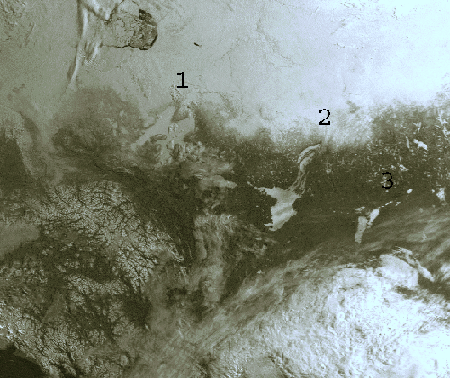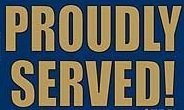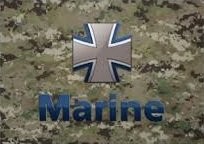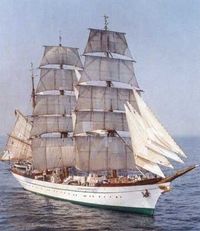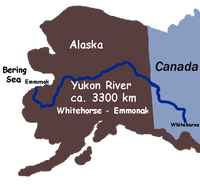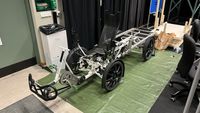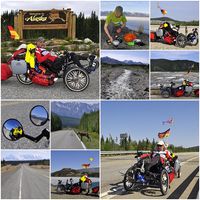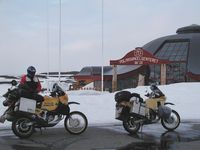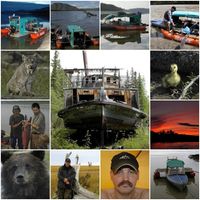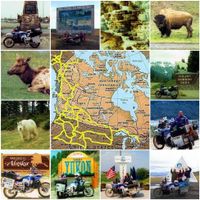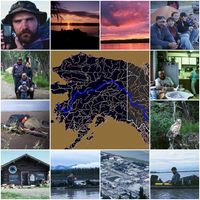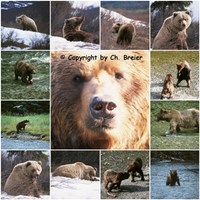Fort Chipewyan
Crazy weather, one day hot next day snowing...
Snow on ORCA in Fort Chip...
ORCA in the harbor of Fort Chip
ORCA at the dock
The Lodge above Fort Chipewyan
Dan in the Lodge above Fort Chip
Fort Chipewyan
Recognized as Alberta's oldest community, Fort Chipewyan is located on the extreme northwestern tip of Lake Athabasca and traces its roots to a North West Company trading post built there in 1788. So important was it to the fur trade, some say second only to Fort William on Lake Superior, that it became known as the “Emporium of the North.” To hold true to the history of Fort Chipewyan, a small museum in the community offers visitors and residents alike an opportunity to view artifacts from the past.
Heavily dependent on air transportation, the community is served by a regional airport and regular Air Mikisew service as well as by charter services. In summer, Fort Chipewyan may be accessed by boat from Fort McMurray and Fort Fitzgerald.
Winter roads link the community to Fort McMurray in the south and Fort Smith in the Northwest Territories. The 280-km trip from Fort McMurray takes only a few hours—unlike in 1924 when the Ryan Brothers hauled mail and freight between Fort McMurray and Fort Chipewyan with horses and sleighs. That trip, one way, took six days!
Resource industries are the major source of employment for residents, along with government (health, education and social service jobs) and a growing tourism industry linked to nearby Wood Buffalo National Park. The community also has several commercial facilities, including general stores, restaurants, a lodge, bank, bulk fuel station, taxi service, engine repair shop, souvenir shop and charter services. Other facilities are a water treatment plant and a sewage lagoon. Garbage collection and recycling systems are in place.
The community has a local RCMP detachment with five officers, a well-equipped volunteer fire department and ambulance service, as well as medical aid emergency and medi-vac services. Education is also available locally for K to Grade 12.
Fort Chipewyan ranks as the second largest community in the municipality, with a population of 1,012.
Museum in Fort Chip
History of Fort Chipewyan
Alberta's Oldest Continuously Inhabited Settlement
by Sister Archonge J. Brady, sgm.
Produced by: Fort Chipewyan Education North Society 1983
1670 - 1799 Year Event
1670 The Company of Adventures of England, trading out of Hudson Bay (known as the Hudson's Bay Company) chartered by Charles II
1697 Intertribal wars. The Cree drove the Chipewyan Indians north and east of the Athabasca district. The Cree had guns obtained from the fur traders.
1700 The Chipewyan acted as middlemen between the western tribes and the Hudson's Bay Company fur trading post at York Factory
1715 William Stewart of the Hudson's Bay Company was the first Eurpoean to travel in the MacKenzie watershed. He tried to make peace amont the Indians and encouraged them to bring their furs to the Hudson Bay forts.
1719 Swan, The Cree, brought a sample of the Athabasca tar sands to York Factory. It was thought to be worthless.
1730 Approximate date Alberta Indians acquired horses and guns.
1754 First white man, Anthony Henday, arrived in Alberta.
1764 Cree and Chipewyan tribes signed a peace treaty at Peace Point.
1772 Samuel Hearne went overland from Hudson Bay to the Coppermine River and the Arctic Ocean.
1778 Peter Pond crossed the Methy Portage and built Pond's Fur Trading Post on the Lower Athabasca River, forty miles form Lake Athabasca near the Embarras Portage. It was the first fort in the Arctic Drainage System and Alberta's first white settlement.
1779 The North West Fur Trading Company was formed in Montreal. Pond joined in 1784 and Alexander MacKenzie in 1787.
1782 Cree and Beaver Indians make peace at Peace Point
1784 Smallpox killed 90% of the Chipewyan Tribe.
1787 Peter Pond grew vegetables at his post, Albert's first garden. Peter Pond's map depicted the Pacific Ocean 150 miles west of Fort Chipewyan. He had to depend on hearsay.
1788 Alexander MacKenzie had his cousin, Roderick MacKenzie, relocate Pond's House to Old Fort Point on the south shore of Lake Athabasca. The new fort was called Fort Chipewyan.
1789 Alexander MacKenzie left Fort Chipewyan to seek a short route to eastern fur markets. He reached the Arctic Ocean by his River of Disappointment, later called the MacKenzie River. He took 102 days and was looking for the Pacific Ocean.
1790 Roderick MacKenzie built a library at Fort Chipewyan. It eventually had 2000 books.
Philip Turnor and Peter Fidler conducted the first survey of the Athabasca and Slave areas. They were Hudson's Bay men hired by the British Government to check Pond's map.
1792-1793 Alexander MacKenzie wintered at the junction of the Peace and Smoke Rivers. On July 22, 1793 he reached the Pacific Ocean. The overland route was not practical for the fur trade. MacKenzie returned to Ft. Chipewyan on September 24, 1793 and spent the winter here. (Ref. 5; See History for references)
1795 Edmonton House was built on the Upper Saskatchewan River.
1798 Fort Chipewyan was relocated to its present site on the northwest shore of Lake Atabasca.
1799 The XY Company was established at Little Island (Mission Point). This new company was sponsored by Alexander MacKenzie, then in Montreal.
1800 - 1899
Year Event
1802 Peter Fidler built Nottingham House on English Island for the Hudson's Bay Company.
Alexander MacKenzie was knighted for his Canadian explorations.
1804 The XY Company was taken over by the North West Company
The first horse was brought by boat from Peace River
Surveyor David Thompson visited Fort Chipewyan to tie in his map of the Great North West.
1805 Simon Fraser visited Fort Chipewyan on his way to the Pacific Ocean.
1806 The North West Company destroyed Nottingham House and Peter Fidler had to abandon the Hudson's Bay Company post.
1815 John Clarke led one hundred Hudson's Bay Company men to Potato Island and built Fort Wedderburn. They ran out of food and John McGillvary, chief factor of the North West Company at Fort Chipewyan a mile away, refused help. Clarke and fifty men went to Fort Vermilion. At Loon River, sixteen men turned back; only three reached Fort Wedderburn.
1816
1817 In the final stage of open war between the two fur trading companies on Lake Athabasca, Fort Wedderburn fell. The North West Company held John Clarke hostage.
1818 Colin Robertson became factor at Fort Wedderburn.
1819 Doctor William Todd of the Hudson's Bay Company arrived at Fort Wedderburn and became the first physican to practice in Alberta.
1820 Captain John Franklin stopped in Fort Chipewyan for four months on his way to the Arctic.
George simpson, 33 and later Governor of the Hudson's Bay company, replaced Colin Robertson at Fort Wedderburn.
Sir Alexander MacKenzie died in Scotland.
1821 On March 26, 1821, the bitter rivalry in the fur trade ended when the North West Company was absorbed by the Hudson's Bay Company. The North West Company had 97 posts and the Hudson's Bay Company had 76. Fort Wedderburn was abandoned in favor of Fort Chipewyan.
1822 The first York boats used on the Athabasca were built in Fort Chipewyan.
1826 The Hudson's Bay Company withdrew liquor from the fur trade.
1834 A cow and calf were brought to Fort Chipewyan.
1837 Thomas Simpson and party travelled from Fort Garry (near Winnipeg) to Fort Chipewyan by dog tream. It took 46 days to travel the 1277 miles or about 28 miles per day. They went to survey the Arctic coastline for the Hudson's Bay Company.
1841 Reverand James Evans, a Methodist, was the first missionary to vist Fort chipewyan. He came by dog team from Peace River.
1843 Domestic animals were in use in Fort Chipewyan.
J. Lefroy conducted a magnetic survey of Fort Chipewyan.
1847-1848 Father Alexander Tache, o.m.i., was the First Roman Catholic missionary to vist Fort Chipewyan. On his second visit in 1848 he chose the site for the Catholic mission.
1851 September 8, the Catholic mission was dedicated to Our Lady of the Nativity.
1852 Father Faraud drained the swamp behind the mission and planted vegetables and grain.
1855 Father Tache decended the Lac La Biche River to the Athabasca River and on to Fort Chipewyan. The R.C. Missionaries decided to use this route to ease their dependency on the Hudson's Bay Company and avoid Methy Portage.
1858 Archdeacon J. Hunter was the first Anglican minister to visit Fort Chipewyan
An icy crust on the snow made hunting difficult and resulted in a near famine.
Distemper killed many wild animals and destroyed most dog teams.
1859 Mrs. Robert Campbell was the first white woman in Fort Chipewyan. She arrived in Alberta with three Grey Nuns at Lac Ste. Anne.
1869 The Hudson's Bay Company monopoly of the fur trade in Rupert's Land ended.
The first scows from the Lac La Biche Mission reached Fort Chipewyan
1870 The Hudson's Bay Company surrendered Rupert's Land to Canada.
M. J. Moberly established Fort McMuray
Roderick MacFarlane reconstructed Fort Chipewyan.
1874 Construction of St. Paul's Anglican Church began and first services were held.
The first Anglican school was opened.
Two Grey Nuns from Fort Providence on the MacKenzie River opened an orphanage and school at Fort Chipewyan.
1875 Botanist John Macoun of the Geological Survey of Canada explored and gave the first scientific account of the Athabasca region.
Brother Alexis Reynard, o.m.i., was killed by his Iroquois guide on the way toe Lac La Biche.
1876 Wheat grown at the R.C. Mission awared a Bronze Medal at the Philadelphia International Exhibition.
1879 St. Paul's Anglican Church and Mission was permanently established. It is still in use today.
1881 Smallpox ravaged the Chipewyan tribe.
1882
1883 Captain J. M. Smith built the S.S. Grahame at Fort Chipewayn. It was the first steamer used in the North. It was 135 ft. long, had a 24 foot beam, and carried 90 tons of cargo. It took 30 hours to go to Fort McMurray and 15 hours to return.
1883 The Hudson's Bay Company constructed a trail from Edmonton to Athabasca Landing, a new route north.
1886 Methy Portage route no longer used.
Transporation by York boats ended.
1887 The Great Famine
1889 Bishop Grouard sent a steam engine to Fort Chipewyan to prepare timber to build a steamboat.
The Athabasca Landing Trail was improved to a wagon road. All freight and passengers going North used that route.
The Hudson's Bay Company built a tramway at Grand Rapids on the Athabasca River to portage all traffic.
1891 The railway reached Edmonton, population less than 2000.
1893 The S.S. St. Joseph was built in Fort Chipewyan at the R. C. Mission. It had a paddlewheel on each side of the steamer. The engine continued to be used to cut wood.
J. B. Tyrell explored from Hudson Bay to Fort Chipewyan.
1897 The Klondike Gold Rush; 780 people passed throught Fort Chipewyan.
Depredations in the North caused by the Klondikers resulted in native people asking for protection of Indian Rights.
1899 Indian Treaty No. 8 was signed by Alexander Laviolette for the Chipewyan and Julian Ratfat for the Cree.
Script was paid to the Metis
160 disillusioned American Klondikers returned south on the S.S. Grahame.
Colin Fraser, Jr., an independent fur trader, re-opened his 1887 fur trading post.
The Royal North West Mounted Police established a post at Fort Chipewyan. It remained open until 1917 and was then reopened in 1923.
1900 - 1978 Year Event
1900 On March 14, Klondiker John Arnot forze on Lake Athabasca during a blizard.
Two mails a year still provided for Fort Chipewyan
The Indians were vaccinated against smallpox at Treaty time.
1905 The Province of Albert was created with Edmonton as its capital.
Five mails a year provided for Fort Chipewyan.
1907 Ernest Thompson Seton stopped in Fort Chipewyan on his way to the Arctic. He hired Billy Loutit as guide.
1908 Leases for commercial fishing on Lake Athabasca granted to white people.
1912 The first Post Office opened in Fort Chipewyan.
The 60th paralled defined as the boundary between Alberta and the North West Territories.
1914 Money replaced the "Made Beaver" as a medium of exchange in trading. The Hudson's Bay Company interested more in retail selling.
1915 The first car, a Ford, was brought to Fort Chipewyan by Brother Charbonneau to be used to haul fish from Goose Island.
1920
1921 Spanish Flu killed many people in Fort Chipewyan. Mass graves were dug where the Hudson's Bay Store now stands.
1922 The Federal Government established Wood Buffalo National Park. Under the direction of J. K. Cornwall, 6600 buffalo were moved by rail and barge from Wainwright to the present park between 1925 and 1928.
1926 Large scale commerical fishing began on Lake Athabasca.
1928 The first seaplane landed at Fraser Bay with a geological photographer for the Federal Goverment. The plane was piloted by C. H. 'Punch" dickens. In 1929, the first airmail was brought to Fort Chipewyan.
1939 All the old Hudson's Bay Company buildings except the Chief Factor's residence were demolished.
1940 The Chipewyan Band chose and was awarded a reservation.
1942 3000 American troops passed throught Fort Chipewyan to Norman Wells to build the Canol Pipeline to Whitehorse, Yukon.
Some soldiers built the station and houses for the Wireless Signal Corps in Fort Chipewyan. They camped at Negro Island on the Rocher River.
1951 The last caribou migration passed through Fort Chipewyan.
1958 The Hudson's Bay Copmpany Fleet ended 135 years of service on the Athabasca - MacKenzie navigation system.
1970 Commercial fishing closed on Lake Athabasca.
1978 Peace Point was set aside as a Cree reservation.
The English Man Nick
One of my Panasonic Toughbooks at work, receiving the latest NOAA - Weather - Sat - Picture .
NOAA Weather Sat Picture, Received with Panasonic Toughbook CF-19 & Xaxero/SkyEye
Nr.1 The Great Bear Lake
Nr.2 The GreatSlave Lake
Nr.3 The Athabasca Lake
All still frozen, the Athabasca is open arround Fort Chipewyan
My new Humminbird 997c Combo GPS Plotter and Side Scan Sonar
ORCA from the inside
Sat NOAA15 29.05.2007. The Lake is finally open in 2 days, amazing...
Thanks a lot to everybody in Fort Chip !
Continue with: Old Fort Chip
Only those who risk going too far, will discover how far they can go!
Expedition in USA, Alaska & Canada, Scandinavia with folding boat, motorboat, catamaran, motorcycle, off-road vehicle, bicycle ...












